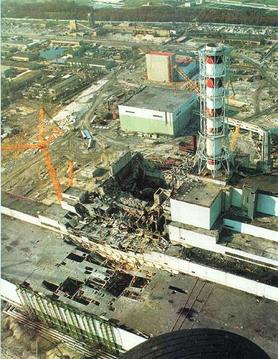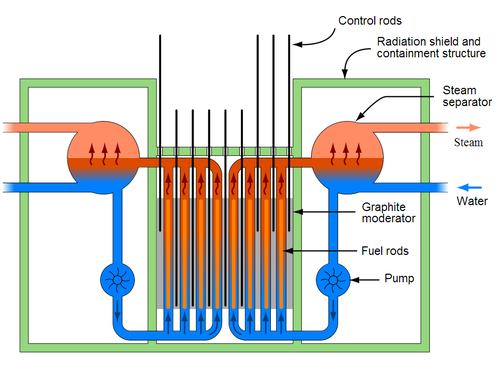Chernobyl nuclear accident

The Chernobyl nuclear accident refers to the events in the Chernobyl nuclear power plant on April 26th 1986. Different articles discuss the radiation release from the Chernobyl nuclear accident and the health effects of the Chernobyl nuclear accident. However, this page will discuss the mechanisms of the the power plant and what lead to the disaster. It is the largest major nuclear accident to date, with 56 casualties and as many as 4000 cases of cancer in the area affected by the fallout.[2] This uses the highly controversial linear no-threshold model which overestimates cancer risk from radiation exposure.
Chernobyl Power Plant
The power plant was located 15 km northwest of the town of Chernobyl (pop. 12,500) and just 3 km away from the town of Pripyat (pop. 45,000) in the Ukraine region of the Soviet Union.[3]
Consisting of 4 RBMK nuclear reactors, which are cooled by water and moderated by graphite, the reactors were relatively old for their time. The Soviet Union invented and developed the RBMK reactor, and at the time there were 27 in operation, with another 16 pressurized water reactors (PWR) operating throughout the country for a total of 43 reactors generating 23,000 MW of electricity—10% of the world's total.[3] As of January 1986, there were another 36 reactors under construction; only 8 of which were RBMK reactors, which shows that the Soviets were moving away from these types towards safer, modern PWR.
RBMK Reactor

The 4 RBMK reactor's fuel was uranium, which was contained in strong enclosed pipes called "pressure tubes", with 1600 of these in a single reactor. The core of the reactor was a large container—about the size of a small house—containing blocks of graphite. Around 1660 holes were pierced through the graphite where the pressure tubes and control rods could fit into it, as seen in Figure 2.[3]
Water was made to flow through the rods and during the nuclear reaction it would heat up, boiling to steam, and would then flow through 2 turbines connected to a generator, in order to generate electricity. The uranium fuel gets very hot during the reaction, so the water flowing over it transfers the heat away from the fuel, which is extremely important. About 5% of the heat from the fuel is transferred to to graphite blocks, thereby heating them up as well.
In other reactors such as the CANDU, coolant is used to cool down the moderator to around 70oC, as well as the fuel. In the RBMK however, this cannot be done. The graphite is at a temperature of around 700oC, where it would have a faint red-hot glow.[3] This was generally not a problem, however, hot graphite burns in the presence of air—therefore, it is extremely important to have no air inside of the core. This was accomplished by containing it in a sealed metal container, circulating inert gases which act to suppress oxygen.
On top of the core was a large concrete shield, which contained all of the control rods—this would play a part in the disaster.
Events Leading to Disaster
Somewhat ironically, the disaster occurred during tests for the plant's safety. The operators had scheduled a test on the back-up power of the reactor in Unit 4, testing how long the turbine could continue to spin in the event of an emergency reactor shutdown. Normally in the case of a shutdown and loss of electrical power, the power plant would receive electricity from the electrical grid in order to safely handle the situation. The power plant also had diesel generators that would start up in the event of power loss, but it took about 30 seconds for them to do so.
The test was centered around the idea that if the electrical grid was down and could not provide power during the 30 second up-time for the diesel generators, the turbine could still spin even after reactor shutdown. It is necessary to always have electricity in the power plant in order to operate safely because it is needed to pump the cooling water over the hot fuel, so this test was felt to be necessary.[3]
The test could only be done before a routine reactor shutdown which was only done once a year, so the operators were under pressure and felt that they had to get it right. If they didn't, they would have to wait a full year to try again. Unit 4 also happened to be a model plant - it ran the best out of all of the RBMK reactors, and the operators likely felt overconfident with their abilities.
To begin the test, the reactor's power would be decreased to 50% of its full operating power—at this point instead of feeding steam to the two regular turbines, it could just be limited to one. Therefore, the test could run on this turbine, and all would be well. Below the events are outlined as they occurred:[3]
| Time | Event | Comments |
|---|---|---|
| April 25 | ||
| 01:00 | Reactor at full power. Power reduction begins. |
As planned. |
| 13:05 | Power at 50%. All steam switched to one turbine. |
As planned. |
| 14:00 | Reactor stayed at 50% power due to unexpected electrical demand. | Electrical grid operators refused to allow the reactor to go below this to the planned 30% power. |
| April 26 | ||
| 00:28 | The operator makes an error, and instead of reaching 30% power, the reactor drops to 1% power almost shutting down. | When this occurs, the core fills with water and xenon gas which is a neutron absorber. This made it nearly impossible to go back up to the desired 30% power. |
| 01:00-01:20 | The operator managed to raise the power to 7% by removal of control rods. He attempted to control the reactor manually, causing fluctuating temperatures and flow. | The reactor is unstable when the core is filled with water. The capability of the ECC is badly weakened and power levels can rise dramatically. There were the equivalent of 6 to 8 control rods in the reactor at this point; the minimum required amount is 30. |
| 01:20 | The operator blocks automatic shut down systems from interfering. | Repeat tests were planned after this, and the operator feared that they would not be able to occur if the reactor was shut down. |
| 01:23 | The operator deemed that it was stable enough to begin the tests. | |
| 01:23:40 | Power began to rise. The operator pushed the manual shutdown button. |
This occurred because of the reduction in flow and the RBMK's large void coefficient. Calculations show that this had the opposite effect to what was intended. The power increased rapidly instead of dropping. It is unclear why he did this, as he was one of the first casualties. |
| 01:23:44 | The reactor reached 100x full power. The fuel disintegrated, and excess pressure broke the pressure tubes. | The high pressure blew off the top shielding and broke all remaining pressure tubes. |
It is important to outline the safety measures that the reactor did have in place to prevent such a disaster. If one of the pressure tubes in the core were to break, a combination of things could happen:[3]
- Mildly radioactive steam escapes and damages the plant
- The uranium gets too hot and is damaged
- Normally contained radioactive material could escape to the outside world
All of these are unacceptable from a public safety and economic standpoint so there were necessary safety measures in place:[3]
- High quality piping. Prevention is always better than a cure.
- Control systems. If a pipe bursts, they shut down the reactor and replace water so the uranium doesn't overheat. This is a mitigation procedure for when things have already gone wrong.
- Special safety systems. Called Emergency Core Cooling (ECC), this system backs up the control systems in order to provide public safety and worker safety. Another mitigation procedure.
- Leak-tight, strong buildings. Even if catastrophic events occur in the reactor, it will be contained inside. All expensive equipment could be destroyed but at least the public would be relatively safe.
At the time of the events, the reactor was only partially contained. All of the pressure tubes below the core were contained above a "bubbler pond" which was a safety measure to ensure leaked radioactive particles would remain in this pool. However, above the core were ordinary industrial buildings. The reason these buildings weren't contained was because they were so large and it would be too difficult and costly to do so.
The operators made some mistakes, however, mistakes should not lead to such disastrous consequences. The problem is that the design was not forgiving of mistakes, as all modern power plants are. Modern plants like the CANDU have layers of safety measures, covering accident prevention, mitigation, and accommodation.
For Further Reading
- Nuclear reactor
- RBMK and CANDU reactor
- Nuclear waste
- Nuclear waste disposal
- Fukushima nuclear accident
- Or explore a random page
References
- ↑ Wikimedia Commons [Online], Available: https://en.wikipedia.org/wiki/Chernobyl_disaster#/media/File:Chernobyl_Disaster.jpg
- ↑ WHO. (June 17 2015). Chernobyl: the true scale of the accident [Online], Available: http://www.who.int/mediacentre/news/releases/2005/pr38/en/
- ↑ 3.0 3.1 3.2 3.3 3.4 3.5 3.6 3.7 AECL. (June 16 2015). Chernobyl - A Canadian Perspective [Online]. Available: https://canteach.candu.org/Content%20Library/19910101.pdf
- ↑ Wikimedia Commons [Online], Available: https://en.wikipedia.org/wiki/RBMK#/media/File:RBMK_reactor_schematic.svg

